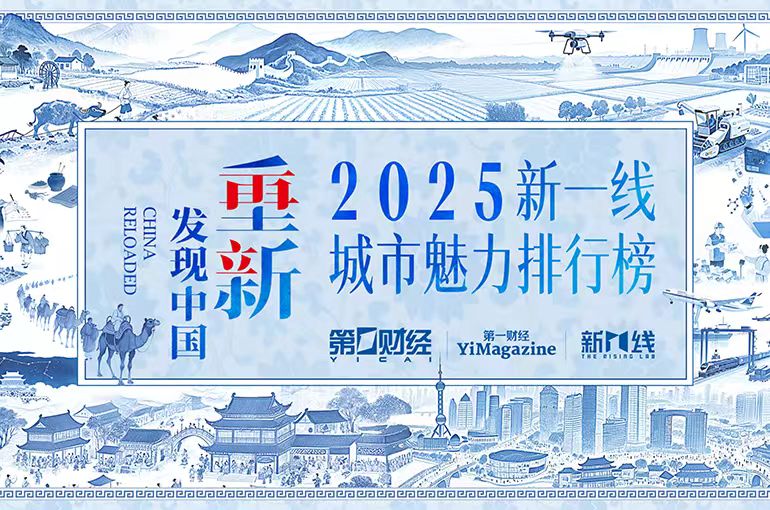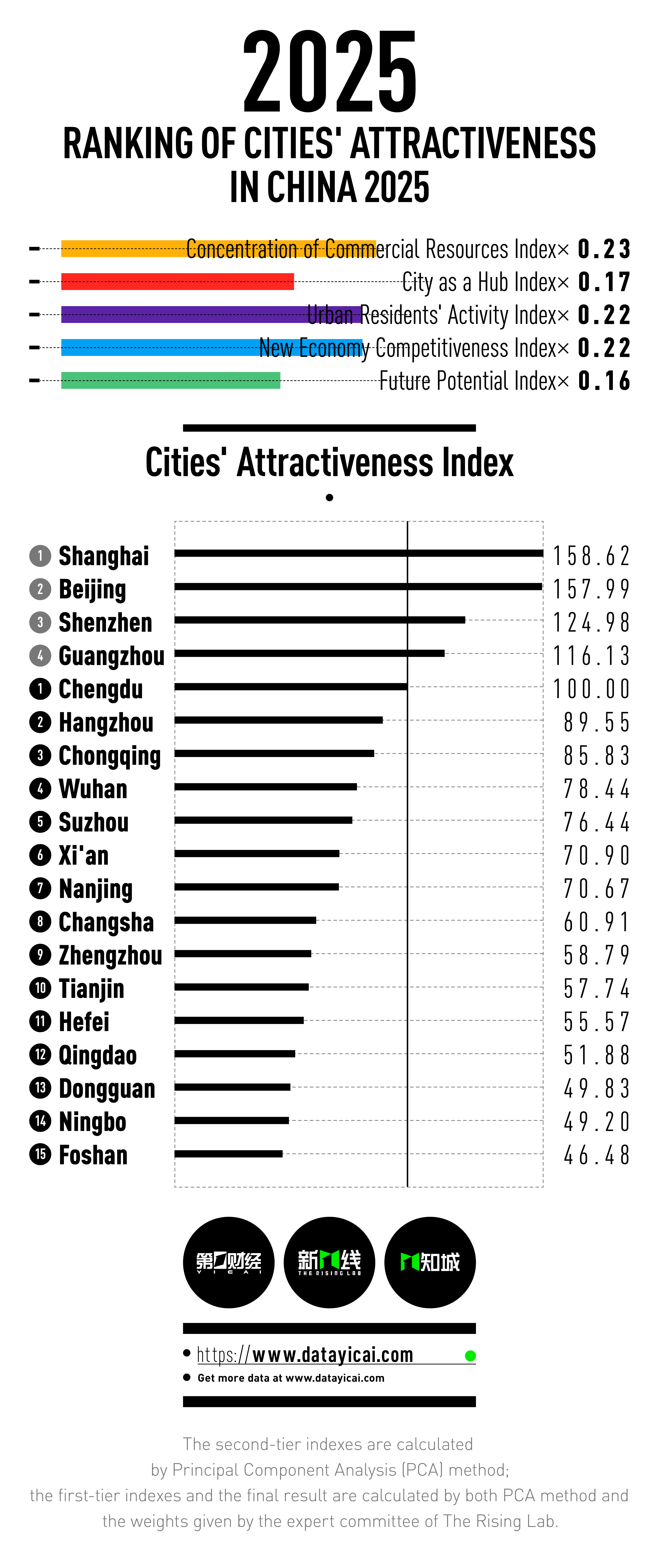 Chengdu, Hangzhou, 13 Others Rank as New First-Tier Chinese Cities in 2025
Chengdu, Hangzhou, 13 Others Rank as New First-Tier Chinese Cities in 2025(Yicai) May 28 -- Chengdu, Hangzhou, Chongqing, Wuhan, and 11 other Chinese cities have entered this year's new first-tier cities ranking, which assesses the overall attractiveness of 337 cities at the prefecture level and above.
Suzhou, Xi'an, Nanjing, Changsha, Zhengzhou, Tianjin, Hefei, Qingdao, Dongguan, Ningbo, and Foshan were the rest to be named as new first-tier cities in the Ranking of Cities' Attractiveness in China 2025 released yesterday. The country's four first-tier cities -- Shanghai, Beijing, Shenzhen, and Guangzhou -- maintained a stable ranking.
This year's ranking continues to utilize the upgraded version of the 2024 Index system, which assesses the efforts and achievements of each city in the past year in five criteria: Concentration of Commercial Resources Index, City as a Hub Index, Urban Residents' Activity Index, New Economy Competitiveness Index, and Future Potential Index.

Hefei jumped to 11th from 15th on this year's new first-tier cities list from a year earlier, making the biggest jump among all cities and reaching its highest ranking since the list was launched a decade ago. It surpassed Dongguan, Wuxi, Ningbo, and Qingdao.
The line graph depicts the competitive landscape of cities across different tiers, highlighting ranking changes between 2016 and this year.
Several joint efforts have been made to use data to "rediscover" China's cities. Young people have adopted more diverse criteria when picking cities, reshaping urban attractiveness. Beyond job opportunities, factors including proximity to hometowns, elderly and child care needs, and the balance between quality of life and living costs are becoming increasingly important.

Provincial capitals hold a clear advantage in these aspects. By investing in major projects, developing high-value-added industries, and building distinctive city brand images, such cities have seized the opportunity to create a self-reinforcing cycle of population, capital, and technological innovation. Other cities mainly thrive when 'getting noticed.'
Whether cities are focused on culture and tourism or driven by industrial development, they are essentially doing the same thing: amplifying their core competencies and reducing their weaknesses.
Interpretation of Indicators
In the indicator system of the Ranking of Cities' Attractiveness in China 2025, the weight of the five primary criteria and secondary measures is determined by scoring from the Rising Lab's expert committee. Data below the secondary dimension are analyzed using principal component analysis.
All sub-dimensional indicators were primarily calculated using data from the start of last year up to early this year.
The Concentration of Commercial Resources Index comprises three sub-indexes: the Big Brands' Attraction Index, Commercial Core Index, and Basic Commerce Index.
The brand location strategy follows an "efficiency-first" logic. Regarding "time lag" for brand entry, Chengdu trails Shanghai by only one and a half months, with Hangzhou, Nanjing, and others maintaining a stable gap within six months. Chengdu and Hangzhou have surpassed others thanks to new consumer product categories such as coffee and outdoor sports, while the per capita availability of lifestyle services is leading in new first-tier cities.
The City as a Hub Index has four sub-indexes: the Traffic Connectivity Index, Intercity Flow Index, Industry Collaboration Index, and Business Resource Regional Primacy Index.
Guangxi Zhuang Autonomous Region achieved full high-speed rail coverage across all prefecture-level cities this year, significantly enhancing connectivity in Baise, Guigang, and others. Companies are strengthening supply chain synergy by establishing cross-regional branches, with firms from Hangzhou expanding into cities such as Shanghai, Hefei, and Shenzhen.
In addition, the commercial landscape in Northeast China is evolving from a dual-core structure centered on Shenyang and Dalian to a more multi-centered pattern that includes Changchun and Harbin.
The Urban Residents' Activity Index assesses the liveliness of urban residents in consumption, leisure, and nighttime activities.
Since last year, cultural and tourism consumption in small and medium-sized cities has expanded dramatically, led by influential cities including Harbin, Datong, and Zhangjiajie. Box offices in third-tier cities accounted for 25 percent of China's total during this year's Chinese New Year holiday. Nighttime travel in Central, Southwest, and Northwest China jumped over 20 percent from a year earlier.
The New Economy Competitiveness Index reflects the endogenous power of city development, comprising the Leading Company Index, New Consumption Index, and Industrial Chain Ecology Index.
Suzhou, Hefei, Chongqing, and similar cities have grown their share of integrated circuits, new energy, and high-end equipment production, while Changzhou and Jiaxing intensified the promotion of local firms going public. Traffic in Harbin has decreased, but Hefei, Dongguan, and others continue to grow on social media apps like Xiaohongshu.
The Future Potential Index has three sub-indexes: the Innovation Index, Talent Attractiveness Index, and Urban Scale Index, highlighting cities' long-term load capacity.
Wuhan, Xi'an, and Nanjing are among the top new first-tier cities by scientific research institutions, making them major innovation resource hubs. Xi'an, Wuhan, Yinchuan, and Chengdu have attracted over 70 percent of their provinces' college graduates, resulting in a "nucleus within the province" structure.
Hangzhou and Wuhan excel in providing medical resources, whereas the Central Plains, Middle Yangtze River, and Chengdu-Chongqing urban agglomerations rank among the top in China by the number of new employees.
Editor: Martin Kadiev